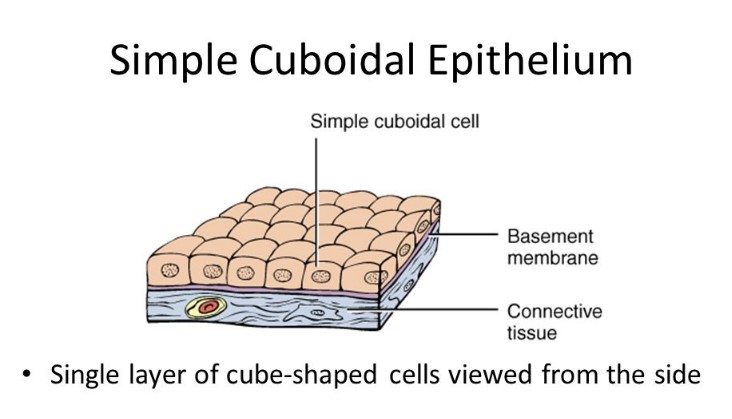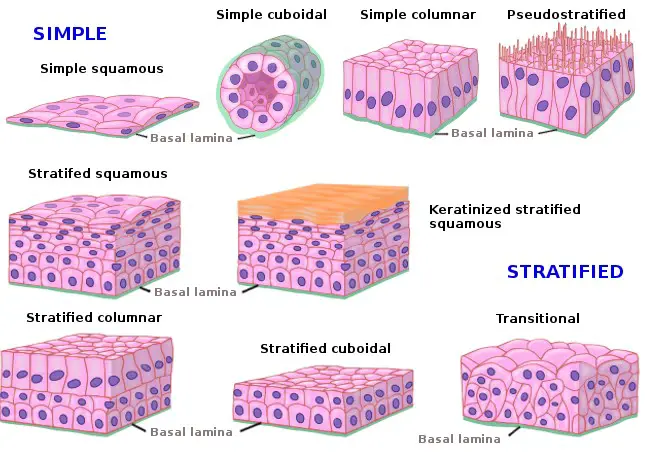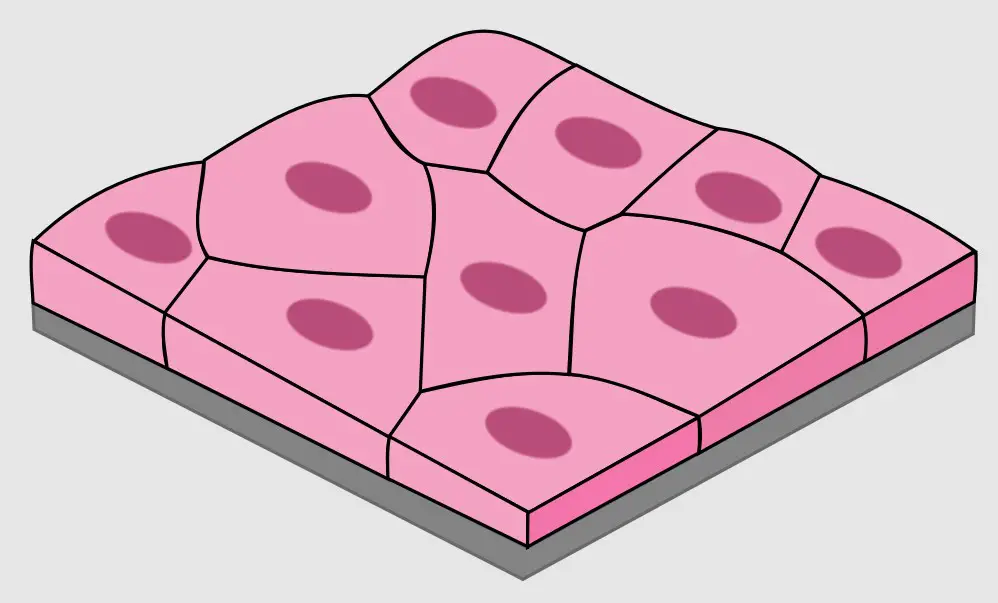Epithelial tissues are fundamental components of the human body, forming the linings of organs and structures and playing crucial roles in protection, secretion, and absorption. These tissues are categorized based on cell shape and the number of layers, among which simple squamous and simple cuboidal epithelia are widely studied due to their specific functions and structural properties.
The key difference between simple squamous and simple cuboidal epithelium lies in their shape and location. Simple squamous epithelium consists of thin, flat cells and is primarily found lining areas where passive diffusion of gases and fluids occurs, such as in the alveoli of lungs and the lining of the heart. Simple cuboidal epithelium, composed of cube-shaped cells, is typically located in areas requiring secretion and absorption, such as in kidney tubules and ducts of small glands.
Understanding these epithelia’s structural differences and functions helps illuminate their critical roles in maintaining organ functionality and overall health. The efficient functioning of each cell type supports vital processes from respiration to renal function, highlighting their importance in biological systems and medical studies.

Basic Concepts
Definition of Epithelial Tissue
Epithelial tissue, one of the four main types of tissues in the body, serves as a protective and functional layer covering internal and external surfaces. This tissue classifies into various forms based on cell shape and the number of cell layers present. Epithelial cells form continuous sheets that cover surfaces such as the skin, internal passageways, and the lining of hollow organs. They play a fundamental role in protecting the body from external threats, such as microbes and dehydration, by creating barrier layers.
Roles of Epithelial Cells
Epithelial cells have several critical functions in the body:
- Protection: They shield underlying tissues from mechanical injury, harmful chemicals, and invasion by pathogens.
- Absorption: Cells in organs like the intestines absorb nutrients and other substances from external environments.
- Secretion: Glands composed of epithelial cells produce and release substances such as enzymes, hormones, and sweat.
- Excretion: Epithelial cells in the kidneys filter out waste products from the blood for excretion.
- Sensory Functions: Certain epithelial cells can detect changes in the environment and help in sensory perception.
The diversity in function is largely due to the specialized structure and location of the epithelial cells, which adapt to meet the specific needs of different body areas.
Simple Squamous Epithelium
Structural Characteristics
Simple squamous epithelium consists of a single layer of flat, thin cells. These cells appear like tiles when viewed from above and like thin scales when viewed from the side. The simplicity in the structure and the thinness of the cells facilitate a fundamental role in diffusion and filtration processes. This epithelial type exemplifies how cell structure is intricately linked to its function.
Key Locations and Functions
This type of epithelium is strategically positioned where passive diffusion of gases or fluids is essential:
- Lungs: Lines the alveoli (air sacs), where gas exchange (oxygen in, carbon dioxide out) occurs.
- Blood Vessels: Forms part of the endothelium, the lining inside heart chambers and blood vessels, aiding in smooth blood flow and nutrient transport.
- Kidneys: Covers parts of the nephrons, contributing to the filtration of blood and urine formation.
The presence of simple squamous epithelium in these locations underscores its crucial role in barrier and exchange mechanisms that are vital for organ function and overall health.
Advantages in Specific Organs
In each location, the advantages of simple squamous epithelium are tailored to enhance organ performance:
- Efficiency in Diffusion: The thin, flat nature of squamous cells offers minimal resistance to the diffusion of gases and fluids, making it ideal for areas like the lungs and blood vessel linings.
- Low Friction Surface: The smoothness of the epithelium helps reduce friction inside blood vessels, promoting easier blood flow and reducing damage to both the blood and the vessel walls.
- Selective Permeability: Despite its thinness, this epithelium selectively allows substances to pass through, ensuring that organs like the kidneys can effectively filter out toxins while retaining essential nutrients.

Simple Cuboidal Epithelium
Structural Characteristics
Simple cuboidal epithelium is composed of a single layer of cube-shaped cells. These cells, often as tall as they are wide, are centrally located nuclei, creating a uniform appearance. The structure of these cells facilitates their primary roles in secretion and absorption due to their larger cellular volume compared to squamous cells. This volume allows for more room for organelles that participate in metabolic processes and intracellular transport.
Primary Locations and Roles
Simple cuboidal epithelium is predominantly found in areas that require active secretion and absorption. Key locations include:
- Kidney Tubules: Here, it aids in the reabsorption of water and ions from the urine and the secretion of substances into it.
- Salivary Glands: It plays a role in the secretion of saliva.
- Pancreatic Ducts: Involved in the secretion of pancreatic juices, which are crucial for digestion.
These locations highlight the epithelium’s essential role in the proper functioning of excretory and glandular systems.
Functional Importance
The primary function of simple cuboidal epithelium includes:
- Secretion: These cells produce and secrete substances like enzymes, hormones, and other vital fluids.
- Absorption: They are involved in the uptake of vital nutrients and minerals necessary for bodily functions.
The strategic placement and functional capabilities of these cells underscore their importance in maintaining homeostasis and facilitating various physiological processes.
Comparative Analysis
Structural Differences
Comparing simple squamous and simple cuboidal epithelia, the main structural difference lies in the shape and size of the cells. Squamous cells are flat and thin, maximizing their area for diffusion, while cuboidal cells are roughly equal in height and width, designed for storage and secretion.
Functional Differences
The functions of these cells correlate closely with their structures:
- Simple Squamous: Optimal for quick diffusion and filtration due to the minimal barrier thickness.
- Simple Cuboidal: Suited for secretion and absorption, benefiting from a larger cellular volume for more extensive intracellular machinery.
Location-Specific Roles
In the lungs, simple squamous cells facilitate rapid gas exchange, while in the kidneys, simple cuboidal cells are crucial in the selective reabsorption and secretion that dictate bodily fluid and electrolyte balance. This specificity ensures that each cell type optimally serves its physiological location.
Practical Implications
Medical Relevance
Understanding these epithelia is crucial in medical diagnostics and treatments:
- Cancer Research: Many cancers originate from epithelial cells, so understanding these cells’ properties can aid in identifying how cancers proliferate.
- Tissue Engineering: Knowledge of epithelial cell structure and function aids in developing synthetic tissues and organs.
Research Applications
The study of these epithelial types extends to:
- Regenerative Medicine: Leveraging their regenerative properties to develop improved treatment methods for organ damage.
- Pharmaceutical Testing: Using these cells in models to study the absorption and effects of new drugs.
Frequently Asked Questions
What is Simple Squamous Epithelium?
Simple squamous epithelium consists of a single layer of flat, thin cells that line surfaces where passive diffusion of substances occurs. This type of epithelium is crucial in areas like the lungs and blood vessels, where quick and efficient exchange of gases and nutrients is necessary.
Where is Simple Cuboidal Epithelium Found?
Simple cuboidal epithelium is typically found in glandular tissues and in the kidney tubules. Its structure allows for functions such as secretion and absorption, vital in renal function and glandular secretion processes.
How Do Cell Shapes Affect Function?
The shape of epithelial cells influences their function significantly. Flat squamous cells are efficient for diffusion and filtration, while cuboidal cells, with more volume and surface area, are better suited for secretion and absorption tasks.
What Diseases Affect Epithelial Tissue?
Diseases such as cancers, cystic fibrosis, and polycystic kidney disease can impact epithelial tissues. These conditions affect cell function and integrity, leading to severe health issues due to compromised barrier and filter functions.
Conclusion
The study of simple squamous and simple cuboidal epithelium reveals intricate details about cellular functions that are essential for life. These cells not only protect and encase organs but also facilitate critical processes such as filtration, absorption, and secretion. Their strategic placement and specialized structures emphasize the complexity and efficiency of the human body at a microscopic level.
As research continues to unravel more about these epithelial types, our understanding of their roles in health and disease expands, offering potential pathways for innovative treatments and diagnostics that hinge on cellular behavior and characteristics.

